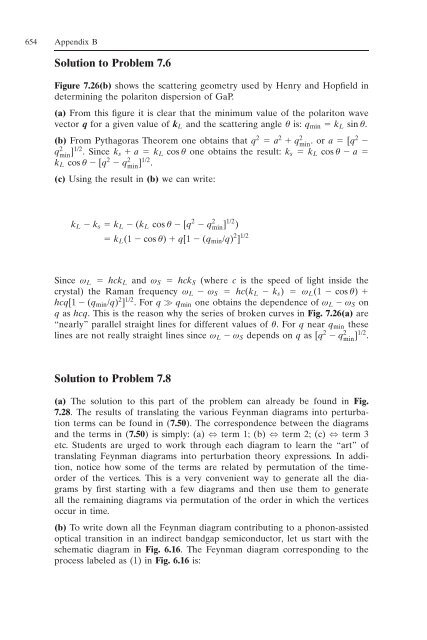10. Appendix
You also want an ePaper? Increase the reach of your titles
YUMPU automatically turns print PDFs into web optimized ePapers that Google loves.
654 <strong>Appendix</strong> B<br />
Solution to Problem 7.6<br />
Figure 7.26(b) shows the scattering geometry used by Henry and Hopfield in<br />
determining the polariton dispersion of GaP.<br />
(a) From this figure it is clear that the minimum value of the polariton wave<br />
vector q for a given value of kL and the scattering angle ı is: qmin kL sin ı.<br />
(b) From Pythagoras Theorem one obtains that q2 a2 q2 min .ora [q2 <br />
q2 min ]1/2 . Since ks a kL cos ı one obtains the result: ks kL cos ı a <br />
kL cos ı [q2 q2 min ]1/2 .<br />
(c) Using the result in (b) we can write:<br />
kL ks kL (kL cos ı [q 2 q 2 min ]1/2 )<br />
kL(1 cos ı) q[1 (qmin/q) 2 ] 1/2<br />
Since ˆL hckL and ˆS hckS (where c is the speed of light inside the<br />
crystal) the Raman frequency ˆL ˆS hc(kL ks) ˆL(1 cos ı) <br />
hcq[1 (qmin/q) 2 ] 1/2 .Forq ≫ qmin one obtains the dependence of ˆL ˆS on<br />
q as hcq. This is the reason why the series of broken curves in Fig. 7.26(a) are<br />
“nearly” parallel straight lines for different values of ı. Forq near qmin these<br />
lines are not really straight lines since ˆL ˆS depends on q as [q 2 q 2 min ]1/2 .<br />
Solution to Problem 7.8<br />
(a) The solution to this part of the problem can already be found in Fig.<br />
7.28. The results of translating the various Feynman diagrams into perturbation<br />
terms can be found in (7.50). The correspondence between the diagrams<br />
and the terms in (7.50) is simply: (a) ⇔ term 1; (b) ⇔ term 2; (c) ⇔ term 3<br />
etc. Students are urged to work through each diagram to learn the “art” of<br />
translating Feynman diagrams into perturbation theory expressions. In addition,<br />
notice how some of the terms are related by permutation of the timeorder<br />
of the vertices. This is a very convenient way to generate all the diagrams<br />
by first starting with a few diagrams and then use them to generate<br />
all the remaining diagrams via permutation of the order in which the vertices<br />
occur in time.<br />
(b) To write down all the Feynman diagram contributing to a phonon-assisted<br />
optical transition in an indirect bandgap semiconductor, let us start with the<br />
schematic diagram in Fig. 6.16. The Feynman diagram corresponding to the<br />
process labeled as (1) in Fig. 6.16 is:










